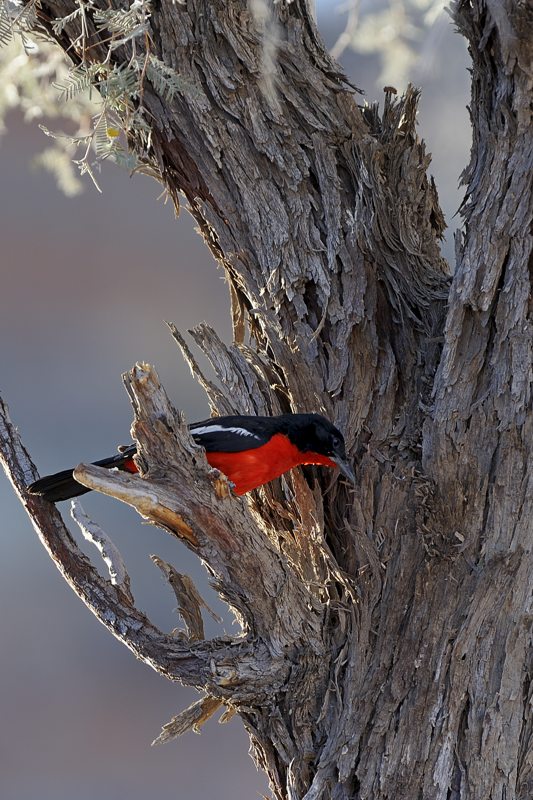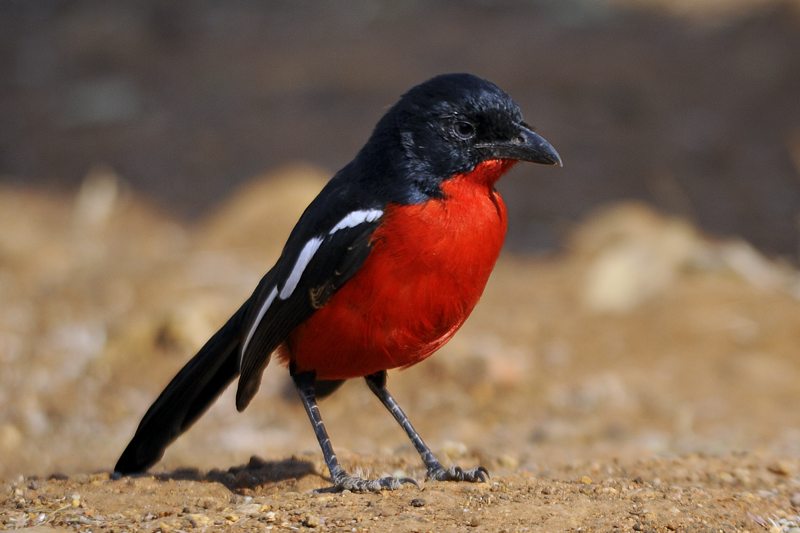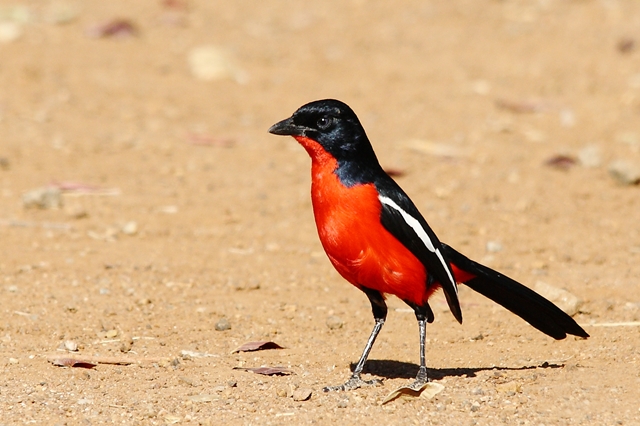https://africawild-forum.com/viewtopic.p ... 29#p165229 Crimson Breasted Shrike
https://africawild-forum.com/viewtopic.p ... 12#p167912 Orange Breasted Shrike
https://africawild-forum.com/viewtopic.p ... 53#p166353 Lesser Grey Shrike
https://africawild-forum.com/viewtopic.p ... 54#p166554 Magpie Shrike
https://africawild-forum.com/viewtopic.p ... 66#p170366 Red backed Shrike
https://africawild-forum.com/viewtopic.p ... 82#p165782 Retz’es Helmet Shrike
https://africawild-forum.com/viewtopic.p ... 33#p173033 Southern White Crowned Shrike
https://africawild-forum.com/viewtopic.p ... 18#p165818 White Crested Helmet Shrike
https://africawild-forum.com/viewtopic.p ... 32#p168932 Common Fiscal
https://africawild-forum.com/viewtopic.p ... 20#p168820 Grey Headed Bush Shrike
and not South African :
Chestnut Fronted Helmet Shrike
Souzas Shrike
White Tailed Shrike
Shrike - BIRD OF THE MONTH JANUARY 2014
- Amoli
- Posts: 6032
- Joined: Fri Jun 01, 2012 4:30 am
- Country: South Africa
- Location: Kempton Park
- Contact:
Shrike - BIRD OF THE MONTH JANUARY 2014 Copy Original
South Africa has 21 regularly occurring shrike species; including
3 skulking Tchagras,
6 colourful Bush-shrikes and
2 vociferous hoodlum Helmet-shrikes.
There are 3 Main families :
1.Laniidae – the biggest family
2.Prionopidae
3.Malaconotidae
1.The LANIIDAE family (the biggest family) has 4 Genes
• Genus: Lanius
Red-backed Shrike Lanius collurio
Souza's Shrike, Lanius souzae
Grey-backed Shrike Lanius tephronotus
Lesser Grey Shrike Lanius minor
Southern Fiscal, Lanius collaris
• Genus: Corvinella
Yellow-billed Shrike, Corvinella corvina
• Genus: Urolestes
Magpie Shrike, Urolestes melanoleucus
• Genus: Eurocephalus
Northern White-crowned Shrike, Eurocephalus rueppelli
Southern White-crowned Shrike, Eurocephalus anguitimens
2. FAMILY: PRIONOPIDAE
Helmet shrikes
3. FAMILY: MALACONOTIDAE
- which includes birds such as Bush-shrikes, Puffbacks, Tchagras, Boubous, Batises and Wattle-eyes
The Crimson-breasted Shrike (Laniarius atrococcineus)
The Bushshrikes are restricted to Africa.
FAMILY: CAMPERHAGIDAE - which is the cuckoo-shrikes and are not closely related to true shrikes.
The Australasian butcherbirds are not shrikes
3 skulking Tchagras,
6 colourful Bush-shrikes and
2 vociferous hoodlum Helmet-shrikes.
There are 3 Main families :
1.Laniidae – the biggest family
2.Prionopidae
3.Malaconotidae
1.The LANIIDAE family (the biggest family) has 4 Genes
• Genus: Lanius
Red-backed Shrike Lanius collurio
Souza's Shrike, Lanius souzae
Grey-backed Shrike Lanius tephronotus
Lesser Grey Shrike Lanius minor
Southern Fiscal, Lanius collaris
• Genus: Corvinella
Yellow-billed Shrike, Corvinella corvina
• Genus: Urolestes
Magpie Shrike, Urolestes melanoleucus
• Genus: Eurocephalus
Northern White-crowned Shrike, Eurocephalus rueppelli
Southern White-crowned Shrike, Eurocephalus anguitimens
2. FAMILY: PRIONOPIDAE
Helmet shrikes
3. FAMILY: MALACONOTIDAE
- which includes birds such as Bush-shrikes, Puffbacks, Tchagras, Boubous, Batises and Wattle-eyes
The Crimson-breasted Shrike (Laniarius atrococcineus)
The Bushshrikes are restricted to Africa.
FAMILY: CAMPERHAGIDAE - which is the cuckoo-shrikes and are not closely related to true shrikes.
The Australasian butcherbirds are not shrikes
Pretoriuskop
Satara
Shingwedzi
20-30 Dec 2014
Satara
Shingwedzi
20-30 Dec 2014
- Amoli
- Posts: 6032
- Joined: Fri Jun 01, 2012 4:30 am
- Country: South Africa
- Location: Kempton Park
- Contact:
Re: Shrike - BIRD OF THE MONTH JANUARY 2014
Crimson Breasted Shrike :
POPULATION & DEMOGRAPHY:
Common. In e Botswana, est 2 birds/10 ha, and 1 bird/ha in Okavango Delta
Densities est 1 pair/2.5-7.0 ha (1 pair/4.5 ha, n = 11) at Olifantsfontein, Gauteng and
1 pair/12.5 ha (no n) at Nylsvlei, Limpopo Province.
Oldest ringed bird 8.2 yr.
MOVEMENTS:
Resident and sedentary, but may move locally into riverine woodland during non-br season
HABITAT: Kalahari thornveld, Acacia savanna and semi-arid scrub with scattered clumps of small trees
GENERAL HABITS: Usually in territorial pairs, occasionally singly.
Agile and active, but secretive; constantly changes posture and jerks or swings tail
Territorial pairs counter-sing and interact with excited bowing, side-to-side movements and tail-jerking.
When foraging on ground, has characteristic upright posture, wing tips pointed down and tail held horizontal, jerking up and down with each bounce.
After a few minutes on ground, scampers up through bush, zigzagging from branch to branch until hidden. \
Roosts on mid- to lower branches of thorn tree, especially Sickle-bush Dichrostachys cinerea, 1-4.5 m (av 2.4 m, n = 175) above ground.
Male and female sleep 1 to a few metres from each other, sitting pressed against tree trunk at base of thick branch.
In a 3-year study, 1 pair used 19 roost sites, typically arriving at roost 5-10 min before sunset, leaving 10 min before sunrise in summer, 15-10 min before in winter.
Flight heavy, with shallow wing-beats.
ref : Roberts bird guide
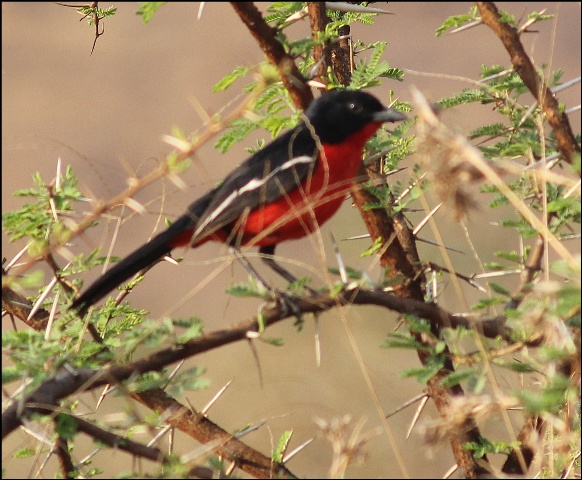
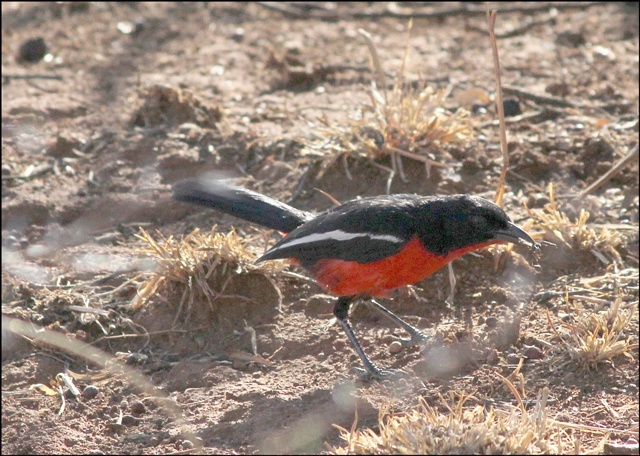
POPULATION & DEMOGRAPHY:
Common. In e Botswana, est 2 birds/10 ha, and 1 bird/ha in Okavango Delta
Densities est 1 pair/2.5-7.0 ha (1 pair/4.5 ha, n = 11) at Olifantsfontein, Gauteng and
1 pair/12.5 ha (no n) at Nylsvlei, Limpopo Province.
Oldest ringed bird 8.2 yr.
MOVEMENTS:
Resident and sedentary, but may move locally into riverine woodland during non-br season
HABITAT: Kalahari thornveld, Acacia savanna and semi-arid scrub with scattered clumps of small trees
GENERAL HABITS: Usually in territorial pairs, occasionally singly.
Agile and active, but secretive; constantly changes posture and jerks or swings tail
Territorial pairs counter-sing and interact with excited bowing, side-to-side movements and tail-jerking.
When foraging on ground, has characteristic upright posture, wing tips pointed down and tail held horizontal, jerking up and down with each bounce.
After a few minutes on ground, scampers up through bush, zigzagging from branch to branch until hidden. \
Roosts on mid- to lower branches of thorn tree, especially Sickle-bush Dichrostachys cinerea, 1-4.5 m (av 2.4 m, n = 175) above ground.
Male and female sleep 1 to a few metres from each other, sitting pressed against tree trunk at base of thick branch.
In a 3-year study, 1 pair used 19 roost sites, typically arriving at roost 5-10 min before sunset, leaving 10 min before sunrise in summer, 15-10 min before in winter.
Flight heavy, with shallow wing-beats.
ref : Roberts bird guide


Pretoriuskop
Satara
Shingwedzi
20-30 Dec 2014
Satara
Shingwedzi
20-30 Dec 2014
Re: Shrike - BIRD OF THE MONTH JANUARY 2014
Dewi
What is the good of having a nice house without a decent planet to put it on? (H D Thoreau)
What is the good of having a nice house without a decent planet to put it on? (H D Thoreau)
Re: Shrike - BIRD OF THE MONTH JANUARY 2014
Laniarius atrococcineus
A bird of the genus Laniarius which was formerly classed with the true shrikes in the family Laniidae, but they and related genera are now considered sufficiently distinctive to be separated from that group as the bush-shrike family Malaconotidae.
One should call it a Crimson-breasted Boubou because it resembles very much its Laniarius brothers, the Southern Boubou and the Tropical Boubou
because it resembles very much its Laniarius brothers, the Southern Boubou and the Tropical Boubou 
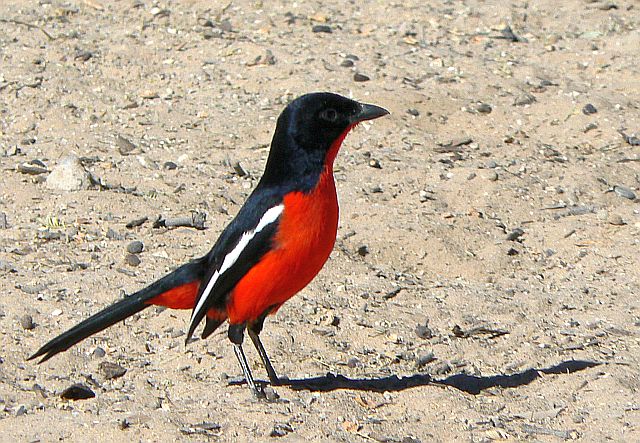
As much as I dislike Nossob camp, I have to admit it's perhaps the best place for Crimson-breasted "Shrike"
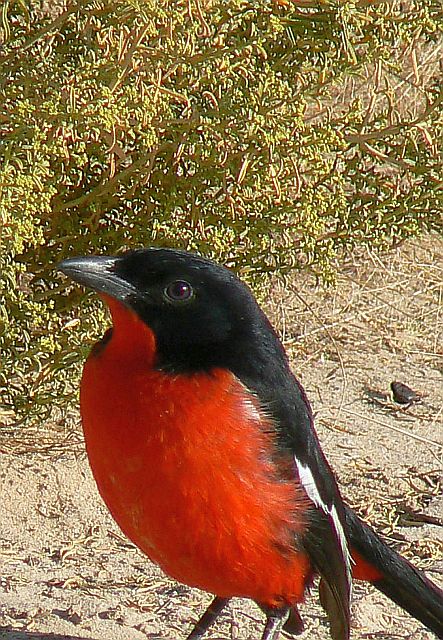
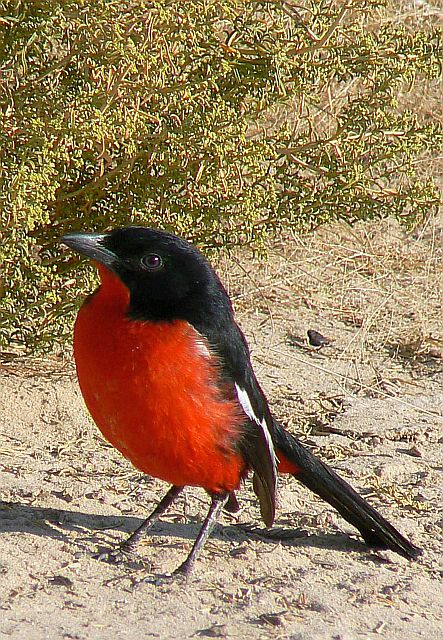
A bird of the genus Laniarius which was formerly classed with the true shrikes in the family Laniidae, but they and related genera are now considered sufficiently distinctive to be separated from that group as the bush-shrike family Malaconotidae.
One should call it a Crimson-breasted Boubou

As much as I dislike Nossob camp, I have to admit it's perhaps the best place for Crimson-breasted "Shrike"


Re: Shrike - BIRD OF THE MONTH JANUARY 2014
Have never seen one outside a camp or picnic spot in KTP 
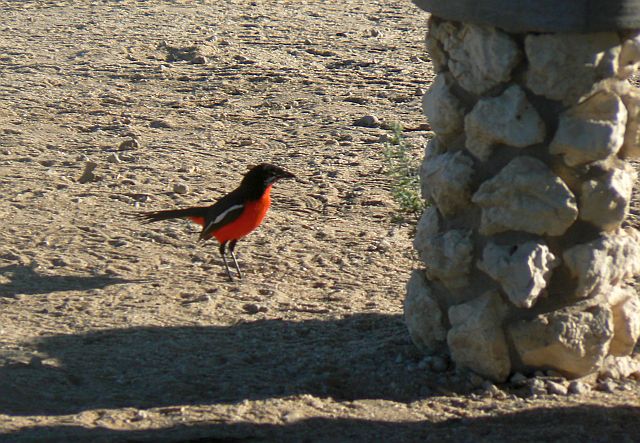

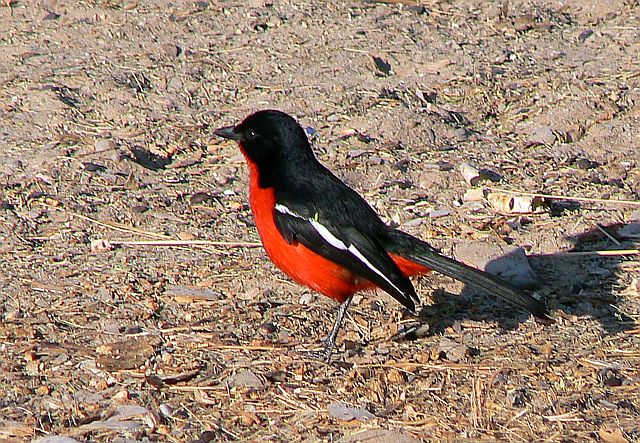
Lijersdraai picnic site



Lijersdraai picnic site
- nan
- Posts: 26454
- Joined: Thu May 31, 2012 9:41 pm
- Country: Switzerland
- Location: Central Europe
- Contact:
Re: Shrike - BIRD OF THE MONTH JANUARY 2014
Kgalagadi 10.9.2009 and 24.9.2012
Crimson-breasted Shrike/Gonolek rouge et noir


Crimson-breasted Shrike/Gonolek rouge et noir


Kgalagadi lover… for ever
https://safrounet.piwigo.com/
https://safrounet.piwigo.com/
Re: Shrike - BIRD OF THE MONTH JANUARY 2014
Sexes are monomorphic with black upperparts to below the eye, black tail and wings showing a white wing stripe. The entire underparts are brilliant crimson except for a yellow morph that occurs occasionally which has lost the ability to transform the yellow food carotinoids into red Astaxanthin based on a gene defect.
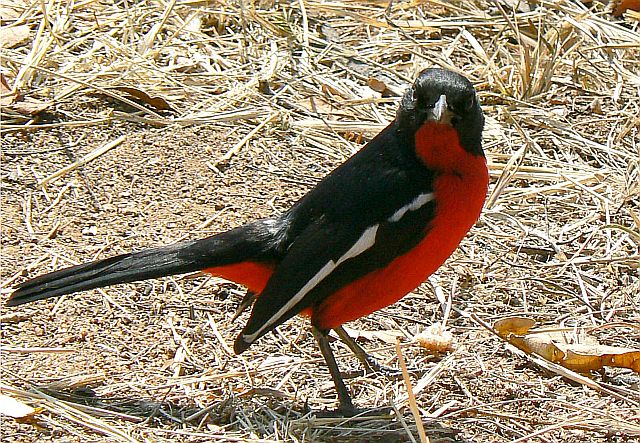
Pilanesberg

Pilanesberg
- Amoli
- Posts: 6032
- Joined: Fri Jun 01, 2012 4:30 am
- Country: South Africa
- Location: Kempton Park
- Contact:
Re: Shrike - BIRD OF THE MONTH JANUARY 2014
The sexes have the same colouration and are indistinguishable from each other. A yellow-breasted form is occasionally seen, and was at first thought to be a separate species. Young birds have a mottled and barred buff-brown appearance with a pale bill.Amoli wrote:
GENERAL HABITS: Usually in territorial pairs, occasionally singly.
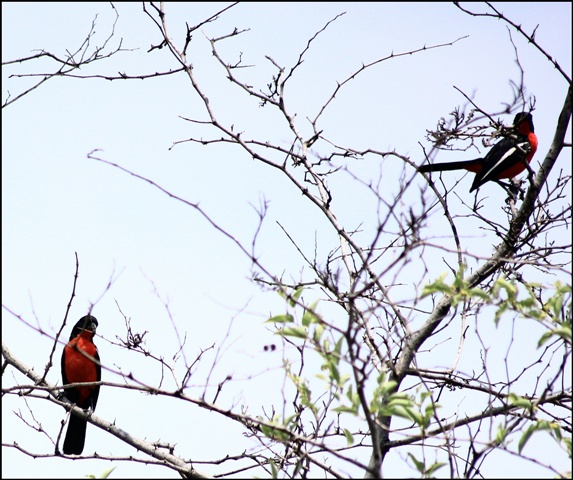
Pretoriuskop
Satara
Shingwedzi
20-30 Dec 2014
Satara
Shingwedzi
20-30 Dec 2014



